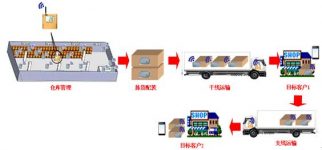
Centralized warehousing cold chain logistics management system
[ad_1]
Centralized storage cold chain logistics management system can be divided into storage temperature management system, warehousing item information management system (formerly inventory management system), refrigerated truck temperature management system, and global positioning system (GPS). From the source to the terminal, build a large platform solution. The entire platform is based on the Internet, GIS (Geographic Information System), database and wireless communication technology, with the Internet, mobile short messages, and wireless transmission as the main access methods, and is a cold chain for warehousing and logistics. Automatic temperature measurement provides an integrated solution. This system provides cold chain temperature monitoring, data collection, data monitoring, data analysis and other services to realize the full-process monitoring of warehousing and logistics cold chain temperature, management of goods in and out of storage, and distribution management.
1. Centralized warehousing cold chain logistics management system plan

Centralized warehousing cold chain logistics management system workflow
1. Warehouse management: organize the raw materials and arrange the warehouse. When entering the warehouse, bind the item information (name, weight, purchase date, warehouse number) with the RFID temperature tag ID number, and turn on the RFID temperature tag. A fixed label collector is installed in the warehouse, and the temperature of the label is collected through the collector and uploaded to the cloud monitoring platform via GPRS/broadband. At this time, the temperature, item information, quantity, weight, purchase date, etc. in the warehouse can all be queried on the platform. When the item is abnormal, it will send an alarm via SMS to notify the management staff to deal with it in time.
2. Picking and assembly: After the order is placed, find the location of the item according to the order, pick and assemble, and bind an RFID temperature tag to each order. After the RFID temperature tag is pre-cooled, it will be opened and put into the package. The number of items in the warehouse is correspondingly reduced, realizing real-time inventory.
3. Trunk transportation: A vehicle-mounted tag collector is installed in the cab of the refrigerated truck. The vehicle-mounted tag collects the temperature of the tag in the box and sends temperature information and location information to the cloud monitoring platform at regular intervals, so as to know the delivery location of the goods in time to ensure Items are in transit in the car. SMS alarms for abnormal situations inform the driver to deal with them in time to ensure the safety of the goods and reduce losses. . Where there is no base station signal, the data is buffered first, and when the signal returns to normal, the data is immediately reissued to the cloud platform to ensure that the data is continuously linked.
4. Target customer 1: In the end, the first target customer, the mobile phone APP prints the temperature data, the customer confirms the signature, opens the box and accepts the goods, and closes the RFID temperature label corresponding to this order. The driver recycles the label and continues to the next stop. The cloud platform records the arrival time of the first stop.
5. Branch line transportation: the waybill will continue to be tracked, the temperature data and location information will be uploaded regularly, and the goods will be counted in time, so that the goods will not be lost.
6. Target customer 2: When arriving at the last customer, the mobile phone APP prints the temperature data, the customer confirms the signature, opens the box and accepts the goods, and closes the RFID temperature tag corresponding to this order. The driver recycles the tag. The cloud platform records the arrival time of each order.
2. The characteristics of the centralized warehousing cold chain logistics management system
1. Diversity of data transmission: The cold chain integrated system integrates RFID wireless radio frequency automatic identification technology, GPRS communication technology, broadband technology, WIFI technology, and GPS positioning technology.
2. Self-developed high-density anti-collision technology: solves the communication interference and communication collision problems of high-density installed wireless temperature tags.
3. The integrity of the data link: In the event of poor GSM network communication, power outages, or cloud server interruption, the detected temperature data will be automatically stored in the instrument’s own memory. Once the communication is restored, the stored data will be automatically reissued to the cloud server. ; The temperature label is also automatically stored. When the collector fails, it will be automatically cached. When the collector returns to normal, the data will be reissued.
4. Real-time inventory of items, anti-lost, anti-string and anti-missing: regular feedback of item status, temperature, transportation trajectory, and order completion status.
5. Full-process monitoring of items: tracking and monitoring of items from warehouse to terminal, continuous chaining to ensure item safety.
6. Abnormal situation alarm: data overrun, external power failure, equipment failure, low battery, communication failure, etc. The alarm adopts the advanced unified gateway alarm function. As long as the receiver’s mobile phone is unblocked, the alarm message can be received, and the system can set multiple alarm message recipients and multi-level alarm modes to improve the possibility of successful alarm reception and record the alarm history .
7. Supervision anytime and anywhere: The cloud server is a B/S architecture. You can access the cloud server to view the temperature and historical records of the cold chain equipment from any place where you can access the Internet.
8. Automatic upgrade program: The client program is required to be able to download automatically and install the latest update patch.
9. Automatic backup function: Support the automatic data backup function in the background.
10. It can be connected with customers’ original purchase-sell-stock software and warehouse management software.
[ad_2]



